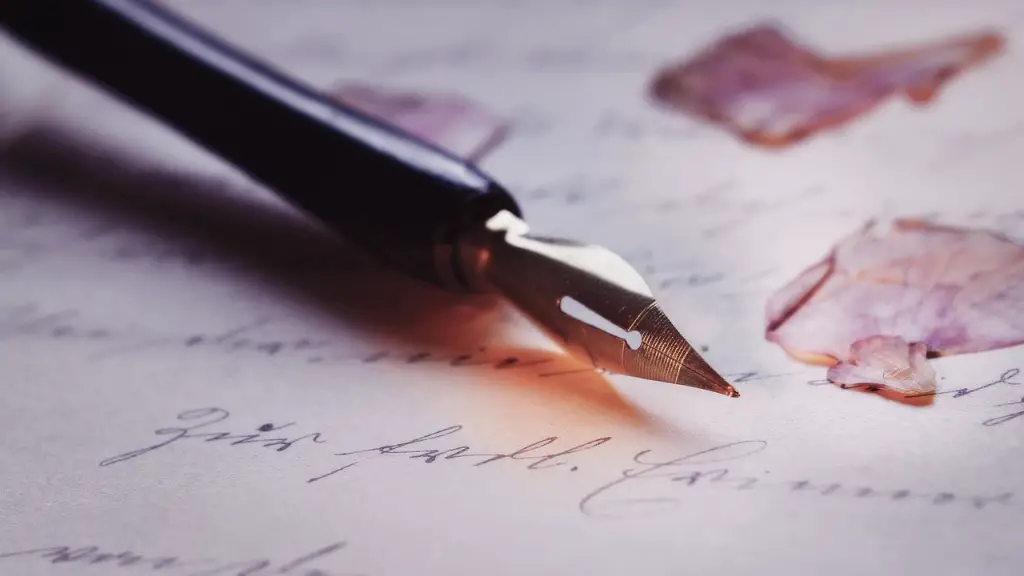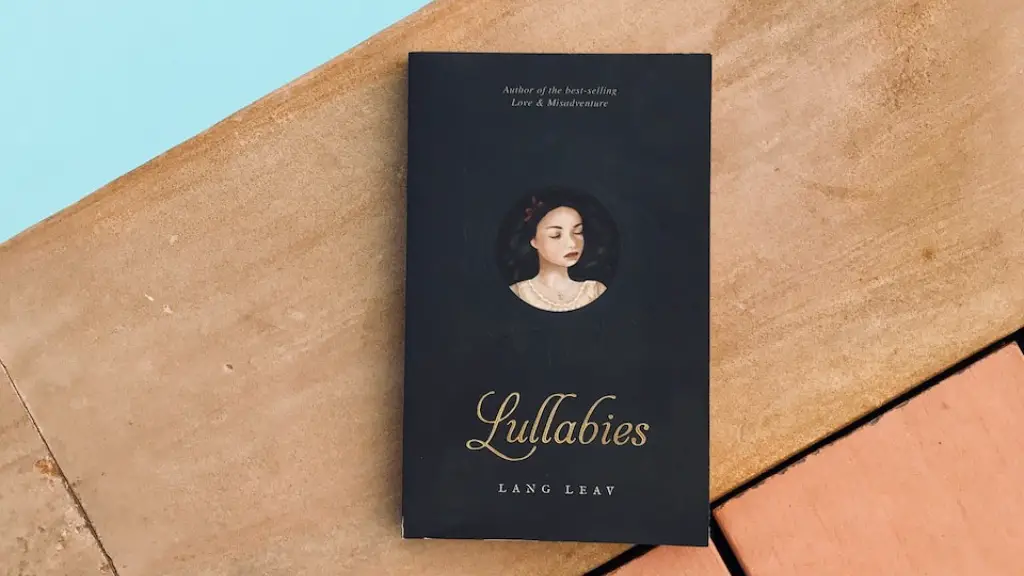Poetry is a means of creative expression that combines language, structure, and pattern. It is often abstract and intangible, yet has an audience that follows literary trends and explores the depths of meaning in a piece of work. Among these depths is the concept of a monologue, which is an extended speech written in the form of a poem that is usually spoken by a single character. Through the use of nuanced symbolism, symbolism-infused devices, and the power of language, the reader is given an immersive experience into the thoughts and emotions of the character.
The purpose of a monologue in poetry is to explore the consciousness of a character. The monologue may be written to share a character’s musings, ponderings, and realizations, while adding a layer of complexity by allowing the reader to vicariously experience the emotions and thoughts of the character. Through the form of the poem, the writer can convey the narrator’s inner monologue and possibly the main themes of the piece. Monologues help to shed light into a character’s inner life, providing a more holistic perspective that encompasses their thoughts, feelings and experiences.
Monologues also address specific topics, events and ideas that can be analyzed for deeper meaning. This additional depth allows for the poem to become more engaging and meaningful to the reader and can be used to discuss complex ideas in a more accessible way. For example, in George Herbert’s ”Easter Wings,” the character reflects on their spiritual journey to acquire salvation and expresses their faith and internal musings in a religious language.
Moreover, monologues in a poem seek to create a sense of immediacy and intimacy between the reader and the character, by providing access to their inner thoughts and experiences. Monologues are also excellent tools to show an unfolding development of one’s character and these can be used to demonstrate how ideas or personalities can evolve over time. In Sylvia Plath’s ”Lady Lazarus, ” the character’s poem is reflective of her developing understanding of her worth, which builds over time as she continues to resurrect from her own metaphor of death.
Overall, monologues in poetry provide an avenue to explore a character and a narrative in the form of an engaging, often lyric poetry. Monologues can explore numerous topics, ranging from spiritual enlightenment and moral awakening to life experiences and crises. Most often considered a dramatic device, monologues can also function as a vehicle to convey much more than words and ideas. Monologues in poetry can evoke compassion, empathy and understanding when used by a skilled writer.
Types of Monologues
A monologue can take on many forms and can be categorized broadly into two main types – interior and exterior monologues. Interiors monologues are the internal musings and reflections of a character, which are generally written in the form of a poem. Exterior monologues, on the other hand, are directed outwards and present personal and oftentimes vulnerable truths about a character’s experiences without internal reflection. An example of a well-written exterior monologue is Robert Frost’s ”The Road Not Taken,” which is composed of abstract language and imagery in order to explore the feelings of an unknown character.
Monologues can also be distinguished by their structure. Typically, monologues are written as one long stanza with enjambment and imagery used to create a visual and emotional journey throughout the poem that allows the reader to connect to the character’s inner world. Alternately, monologues can be written in a series of short stanzas. In this case, the poem shifts between short lines or brief thoughts to emphasize the emotions of the character and to create a sense of levity.
Elements of a Monologue
The elements of a monologue include the use of literary devices such as symbolism, irony, and metaphor. Symbols, for example, can be used to represent intangible concepts and can help to illustrate emotions and inner thoughts. These are especially effective in conveying conflicting emotions in a subtle, yet powerful way. Metaphors are also effective in exploring more abstract concepts in a poetic way, as metaphors create strong visual images that the reader can connect to. Additionally, irony can be used to reveal the character’s thoughts in a more impactful way, as it provides a contrast between the character’s expectation and reality.
Each of these literary devices can also be used to evoke particular emotions from the reader, such as sorrow, joy, or confusion. This can be especially helpful when attempting to develop an intimate relationship between the narrator and the reader, as it allows the reader to vicariously experience the narrator’s journey and inner thoughts. Understanding the specific devices used within a monologue and how they contribute to its effectiveness is a crucial step in interpreting the poem as a whole.
Examples of Effective Monologues
In Ivan Turgenev’s ”The Cherry Orchard,” the protagonist, Gaev, examines his internal thoughts of responsibility and growing self-awareness in a powerful monologue. Here, Turgenev employs the use of symbolism and character insight to address themes of mortality and the natural cycle of life. In Amy Lowell’s ”Dreams,” the speaker explores her inner world of feelings and emotions to contemplate the passing of time and the changes of the physical world. Here, Lowell effectively uses vivid imagery and alliteration to evoke a sense of nostalgia and sorrow as the character reminisces about her past dreams and aspirations.
Finally, in Alfred, Lord Tennyson’s “Ulysses,” the titular character delivers a powerful monologue that explores maturity, mortality and the notion of living a fulfilled life. Here, Tennyson effectively employs the use of metaphors and symbols to evoke the feeling of contemplation and to emphasize the narrator’s internal contemplations. Furthermore, the enjambment used in this poem allows the character’s musings to flow uninterrupted and creates a narrative that is easy to engage with as a reader.
Exploring Monologue Through Poetry Analysis
Increasingly, poets are exploring and experimenting with the concept of monologue to express a wide range of esoteric ideas and emotions. While the structure and composition of a monologue may vary from poet to poet, it is important to analyze the different elements to gain a more complete understanding of the characters, their internal struggles and the motivations of their inner growth and journey. Depending on the poet, one may gain valuable insight and self-reflection by analyzing the device of monologue and its purpose within the work. For example, in Sylvia Plath’s ”Lady Lazarus,” the narrator’s use of metaphor and imagery to discuss her own mortality both shock and captivate the reader while exposing the character’s raw and honest emotions.
Conversely, examining the narrative structure of the poem can provide insight into the character’s development and growth. By observing the succession of the character’s musings, readers can notice shifts in ideas, attitudes and emotions, deciphering patterns and unlocking new truths about the work. Marilyn Nelson’s ”A Wreath for Emmett Till” is a prime example of a monologue that speaks volumes about the injustices faced by Blacks in the Jim Crow era, while encouraging readers to explore the power of the individual’s voice.
The Power of Monologue
In conclusion, while monologue may be considered a dramatic device, poets are increasingly exploring this form of expression to capture fundamental truths and complex emotions. Monologues are incredibly powerful in conveying inner conflicts and thoughts, as well as meaningful themes and ideas that often motivate personal and social change. Poets such as Sylvia Plath, Robert Frost, Amy Lowell, Alfred, Lord Tennyson, Ivan Turgenev, and Marilyn Nelson have all used the device of monologue to its fullest potential, inspiring readers to think more deeply about the world around them and to create meaningful connections to the characters’ inner journey.
The Impact of Monologue in Analyzing Character
Analyzing a monologue is essential in understanding the character. Through examination of its features and its use of literary devices, a closer relationship can be formed between the reader and the character. Character development is prevalent in literature and poetry, and writers use monologues to give their interpretative voice to their characters in order to foster a deeper understanding of their emotions, struggles, and motivations. Monologues provide insight into the character’s internal thought processes, the conflict that they are experiencing, and can be used to progress the character’s journey.
It is also important to consider the use of language and style in a monologue as they create an overall impression and structure of the character. To analyze language effectively, consider the frequency and type of words used as well as the syntax of the poem. The effectiveness of the poem depends on how the ideas and emotions are being presented, so it is important to take into account these features as they can be a reflection of the character’s thoughts. Additionally, one should consider the overall structure of the poem to examine the progression of the character’s journey, as monologues are used to share characters’ thoughts, feelings and motivations in a clear, concise way.
Environmental Factors of Monologue
In many pieces of literature, monologues are used to highlight the environmental factors that contribute to a character’s journey and decisions. Not only are monologues used to highlight internal struggles and motivations, they also can provide insight into external forces that are beyond the character’s control. By understanding the environmental factors that impact a character, the reader can gain an even more insightful understanding of the character’s journey and emotions. Additionally, the use of monologue can be used to highlight the influence of societal pressures and factors of our environment, such as the political climate during certain eras.
Monologues draw heavily on description and detail to create a vivid and immersive atmosphere. This can involve aspects such as setting, tone and atmosphere. Through the use of language and visual interpretations, the monologue has the potential to create a deep, emotional connection with the reader. Therefore, it is important to consider the various factors that contribute to the character’s experience and how these contribute to the overall story and development of the character.
The Role of Monologue in Developing Character
The role of monologue in developing character is an essential one. Characters come alive through their internal dialogue and it is an invaluable tool used in developing characters and storytelling. Through monologues, readers can gain an understanding into the thoughts, feelings, and motivations of the character. Therefore, it is important to consider the development and growth of the character, examining how their monologue changes and evolves over time. This provides the reader with an insight into the character’s journey, aiding the understanding of their position and choices that they have made.
Monologues can be used to address the issues that the character faces, whether this is internal or external. Through the use of metaphor and symbolism, the monologue has the potential to evoke the reader’s emotions while the character’s emotions and struggles are addressed. While monologues can provide insight into a character, it is also important to consider their purpose within the work and how the character is affected by their experiences. Monologues should always be seen as a tool to gain an understanding of the character and their story, informing the reader of their experiences and journey as a whole.





